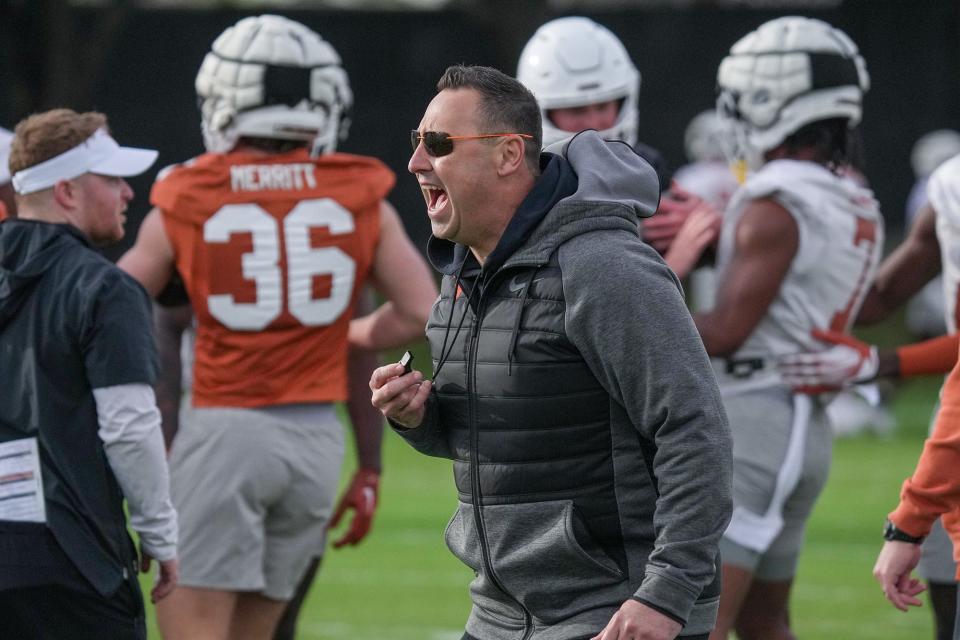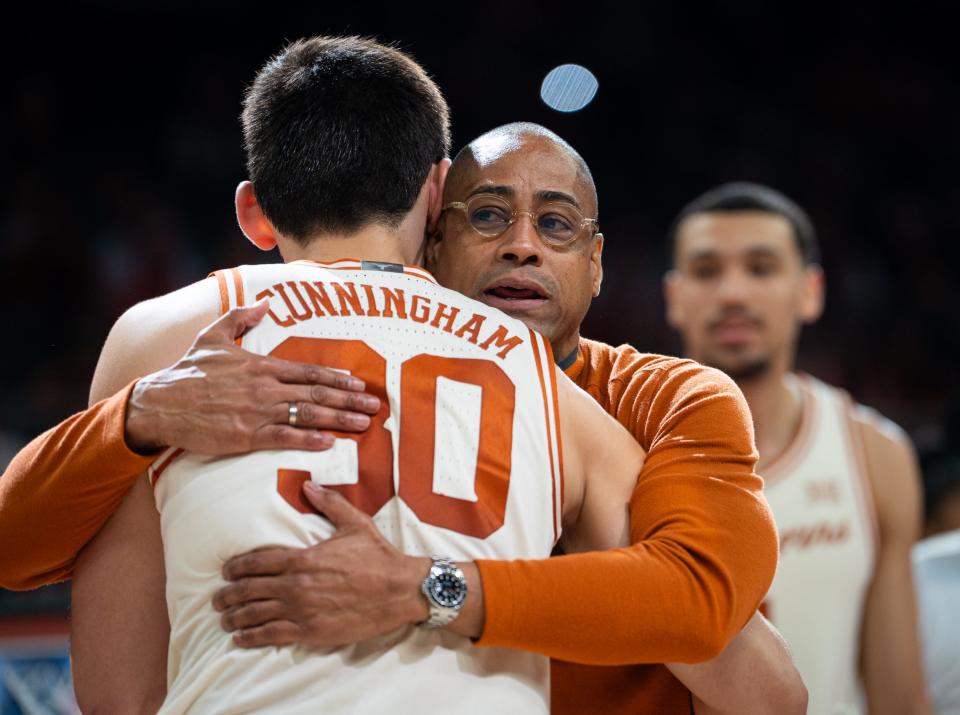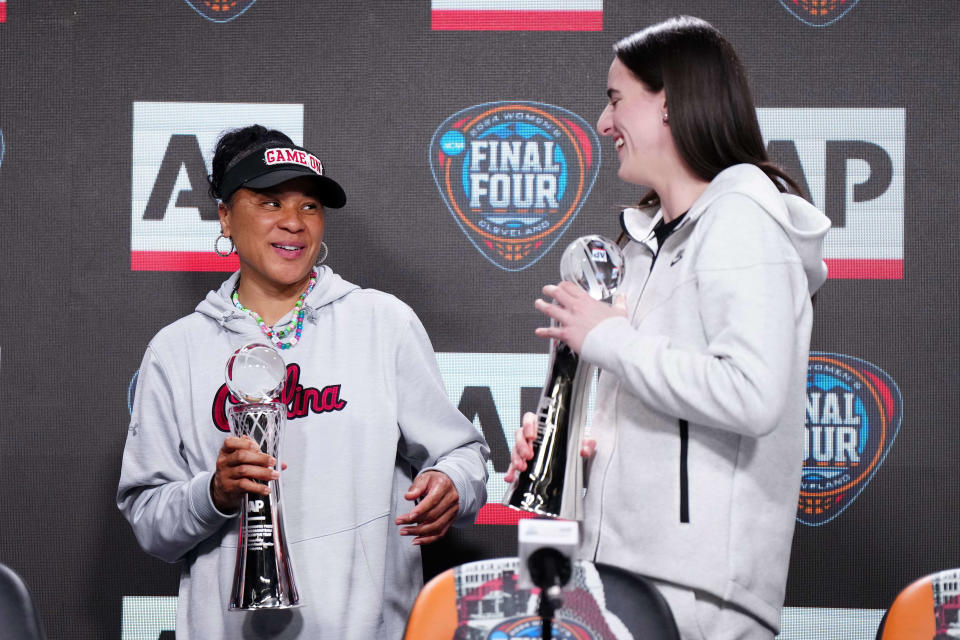Texas football looks for plugs on the defensive line to replace Sweat, Murphy | Golden
You don’t lose the best defensive tackle tandem in the country and fail to feel the impact.
To retain the level of excellence we witnessed from Byron Murphy II and Outland Trophy winner T’Vondre Sweat would be close to a miracle, but the Michigan Wolverines and future SEC opponents are crying no tears for the Texas Longhorns.
Murphy is a sure-fire first-round pick in the upcoming NFL draft and Sweat has the potential to be a good pro if his recent arrest on DWI charges after a weekend wreck isn’t a harbinger of bad things to come.
More: Texas quarterback Quinn Ewers likes the first impressions of his new receivers | Golden
The duo left a gaping hole in the middle of Texas' defensive line and the competition this spring has been good, said head coach Steve Sarkisian, who will hopefully figure out how to come close to replacing the biggest linchpins on the No. 3-ranked run defense in America last season.

More: Crisp Texas quarterback Quinn Ewers gave NFL scouts something to ponder for 2025 | Golden
Vernon Broughton. Alfred Collins. Aaron Bryant. Jaray Bledsoe. Sydir Mitchell. Alex January. Tiaoalii Savea. Somewhere in there, new defensive line coach Kenny Baker will have to come up with a rotation of run pluggers who are sure to be tested this fall.
This is a prime example of why spring football is important. With just over a week remaining until the Orange-White spring game on April 20, these players have an opportunity to get a leg up on the competition while the coaches can gauge technique, motor, strength and that certain degree of nastiness that’s a prerequisite for the trenches.
Conventional wisdom would place the onus on veterans Broughton and Collins to naturally ascend to the starting spots after being part of the regular rotation last season, and surely that’s the hope given that they understand the expectations and are now immersed in Sarkisian's locker room culture.
This time last year, Sarkisian was saying he needed to see more than flashes from Collins, and the Cedar Creek product delivered with his best season. He started six games and came up with two sacks and 12 solo tackles, just one fewer than All-Big 12 first-team selection Murphy.
More: At this point, someone just send Texas' Steve Sarkisian a memo on any new rules | Bohls
"It took a little bit of time, but I can tell you today, we're getting the consistency out of Alfred Collins,” Sarkisian said Tuesday. “We're getting the flash and the consistency, so that's really important.”
While it’s obvious the Horns will need more of the same from the two returning veterans, Sarkisian said that Bryant, a 6-foot-2, 307-pound sophomore, has taken a nice step up this spring while Bledsoe appears to be where Collins was this time last year: flashy, but not there yet in the consistency department.
Mitchell played in four games as a freshman, so he will retain another four seasons of eligibility while January arrives from Duncanville.
More: Who's next for Texas softball after its big win over OU? And where do the Longhorns now rank?
The 6-foot-4, 305-pound Savea will bring experience. He totaled 21 tackles and 1½ sacks at Arizona last season. A former four-star prospect, he played one season at UCLA under defensive coordinator Johnny Nansen, who is now Texas' linebackers coach.
The Horns have solid numbers up front, but don’t be surprised if Sarkisian adds another piece or two from the transfer portal because there isn’t an obvious alpha dog in this group. He could emerge in the summer, or he could show up from elsewhere. It remains to be seen.

Rodney Terry takes care of home, mines the portal
Managing his roster: Texas basketball coach Rodney Terry is back from the Final Four in Phoenix, but he made sure to take care of some home business before he left for the desert.
In this transfer portal age, coaches have to make sure their current players are happy before they can even think about bringing in new faces. So Terry, fresh off a 21-13 season and a second-round finish in the NCAA Tournament, met with each of his players before leaving town.
He talked about not only navigating the portal, but also the importance of staying connected to this players during this week’s "On Second Thought" podcast.
“You need to sit down and visit with your players,” Terry said. “You need to get a good pulse in terms of how they thought the season went, their weaknesses, their strengths, what they need to continue to improve on moving forward and really have a good talk with them.”
We know that forward Alex Anamekwe and guards Chris Johnson and Gavin Perryman have already entered the portal, so those conversations were had as well.
“If there was indeed a guy who was like, ‘Hey, the fit wasn’t right for me or I’m looking for a fresh start somewhere else,’ you just thank that young man for what he gave us that year both on the court, off court and let them know, ‘You will always be in our lives and if there’s anything we can do to help you, we’re going to always try to help you,’” Terry said.
The Horns also lost leading scorers in senior Dylan Disu and graduate Max Abmas to the eligibility monster while guard Tyrese Hunter and forward Dillon Mitchell are weighing their NBA draft options. Hunter was a roller-coaster this season while Mitchell showed some nice improvement overall despite the glaring lack of any sort of consistent jump shot. He isn’t NBA ready.
Link Academy freshman Tre Johnson, a 6-foot-6 guard from Dallas who hit five triples in the McDonald’s All-America Game, is a big-time NBA prospect with a one-and-done look about him. If he lives up to this potential — On3 ranks him as the nation’s No. 5 overall prospect — the Horns will be a fun watch in 2025. Terry compares him to former NBA all-star Dale Ellis.
“He’s going to come in and put his footprints on this program in a big way,” Terry said. “There will be nights when he will score the ball extremely well and there will be nights when he will be a facilitator who will make incredible passes to set guys up. He’s an incredible piece to build around in terms of being a marquee player with the chance to be the face of the program as well.”
There are several pieces left to this puzzle that will include big man Kadin Shedrick and explosive guard Chendall Weaver. Terry will attest, recruiting and portal are always happening in this game.

It’s time for NCAA women’s hoops to cash in
The women are due: With the huge surge in popularity of women's college basketball, thanks this season to the electric Caitlin Clark and the incomparable national champion South Carolina Gamecocks, the NCAA has to start rewarding the ladies for their work, not only on the court but at the box office.
More: DeYona Gaston enters transfer portal after four seasons with Texas basketball program
Women’s teams don’t receive money for qualifying for or advancing in the NCAA Tournament. It's time for that to change.
This isn’t to disparage the men’s tournament, which is a veritable cash cow that’s being operated under a nearly $900 million media rights deal with CBS/Turner that pays out $2 million per winning unit to the school’s conference. Shoot, the Big 12 was guaranteed $16 million just for qualifying eight teams to the tournament.
As for the ladies, we’re not trying to compare them to the men’s game, which has become a Fort Knox of a draw over the last 40 years, but we’re well past the tired belief that people aren’t watching.
South Carolina’s title game win over Clark’s Iowa Hawkeyes drew 18.7 million viewers, topping UConn’s title win over Purdue by nearly four million. It was the most watched college basketball game in six seasons, men or women. Sure, Clark brought the star power for sure, but Dawn Staley’s coaching brilliance and South Carolina's dominance in a 38-0 season provided the perfect complement.
Clark is a generational talent, but the game is in good hands with UConn’s returning senior Paige Bueckers and youngsters like USC's JuJu Watkins, Texas’ Madison Booker and Notre Dame’s Hannah Hidalgo, who are all entering their sophomore seasons. While the men rode the exploits of a UConn team juggernaut, the women soared because they have individual stars and bigger coaching personalities like Staley, LSU’s Kim Mulkey and UConn’s Geno Auriemma.
This wasn’t some solar eclipse one-off. The game is growing. Sportico reported that the NCAA inked an eight-year $920 million deal with ESPN to cover the women’s tournament and 40 other championships. The deal reportedly values the women’s basketball tournament at $65 million per year, which should open up the event for some revenue disbursements during March Madness.
The people are tuning in, overall attendance is on the rise and the product is entertaining.
It’s time to add a financial reward/incentive for the hard work they have put in to grow this sport.
This article originally appeared on Austin American-Statesman: Texas football needs an alpha dog up front on defense

